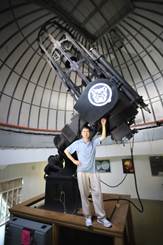讲座题目:小行星自转研究
讲座时间:2018年6月20日,10:00
 讲座地点:X2427
讲座地点:X2427
讲座嘉宾:Xianming Han(韩先明)教授
嘉宾简介:
韩先明,Dept. of Physics and Astronomy, Butler University,Butler大学物理天文系系主任。曾在中科大物理系、安徽光机所学习;Department of Physics, University of Colorado, Boulder,研究生学习,研究方向:原子分子物理。1989-1991在Department of Physics, University of Idaho, Moscow工作,研究方向:原子分子物理。1991-现在:Department of Physics and Astronomy, Butler University, Indianapolis,主要从事观测天文方面研究,研究对象主要是小行星和双星。
报告摘要:
Asteroid collisions with the Earth are the worst possible natural disasters that the Earth can face. And the bad news is that this kind of collisions has happened in the past, and will happen again in the future. Probably the most famous such collision is the one from sixty five million years ago which caused mass extinctions, including the dinosaurs. A recent example is the meteor strike in the Russian Chelyabinsk region on February 15, 2014.
Most asteroids are located in the asteroid belt between Mars and Jupiter. Asteroid rotations result in Yarkovsky Effect, which may cause an asteroid’s orbit to shift to the inner solar system, thus resulting in a possible collision with the Earth. Therefore, it is important to know the rotations of an asteroid in order to fully understand its dynamics.
In this talk, we will present results from our asteroid rotation research. During the last few years, we have used out SARA telescopes located at Kitt Peak National Observatory, at Cerro Tololo Inter-American Observatory, and Canary Islands in Spain, and our on-campus Holcomb telescope, to perform photometric studies for numerous asteroids, and from their light curves, we have extracted their rotation periods. For asteroids with long periods, we also collaborated internationally from both northern and southern hemispheres. The periods that we found range from less than three hours to several hundred hours.
